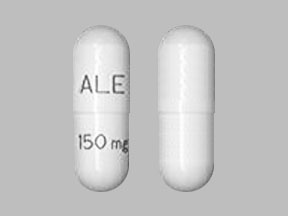Alectinib Dosage
Medically reviewed by Drugs.com. Last updated on Sep 8, 2025.
Applies to the following strengths: 150 mg
Usual Adult Dose for:
Additional dosage information:
Usual Adult Dose for Non-Small Cell Lung Cancer
600 mg orally 2 times a day with food until disease progression or unacceptable toxicity
Comments:
- Select patients for the treatment of metastatic NSCLC based on the presence of ALK positivity in tumor tissue or plasma specimens.
- If ALK rearrangements are not detected in a plasma specimen, test tumor tissue if possible.
Use: For the treatment of patients with anaplastic lymphoma kinase (ALK)-positive metastatic non-small cell lung cancer (NSCLC) as detected by an FDA-approved test
Renal Dose Adjustments
- Mild (CrCl 60 to less than 90 mL/min) or moderate (30 to less than 60 mL/min renal impairment: No adjustment recommended.
- Severe renal impairment (CrCl less than 30 mL/min) or end-stage renal disease: Data not available
- Grade 3 renal impairment: Temporarily withhold therapy until recovery to baseline or to 1.5 x ULN or less, then resume at reduced dose.
- Grade 4 renal impairment: Permanently discontinue therapy.
Liver Dose Adjustments
- Mild (Child-Pugh A) or moderate (Child-Pugh B) hepatic dysfunction: No adjustment recommended.
- Severe hepatic dysfunction (Child-Pugh C): Reduce dose to 450 mg orally 2 times a day.
- ALT or AST elevation of greater than 5 times the upper limit of normal (ULN) with total bilirubin 2 x ULN or less: Temporarily withhold therapy until recovery to baseline or to 3 x ULN or less, then resume at reduced dose.
- ALT or AST elevation greater than 3 x ULN with total bilirubin elevation greater than 2 x ULN in the absence of cholestasis or hemolysis: Permanently discontinue therapy.
- Total bilirubin elevation greater than 3 x ULN: Temporarily withhold therapy until recovery to baseline or to 1.5 x ULN or less, then resume at reduced dose.
Dose Adjustments
Dose Reduction Schedule for Adverse Reactions:
- Starting dose: 600 mg orally 2 times a day
- First Dose Reduction: 450 mg orally 2 times a day
- Second Dose Reduction: 300 mg orally 2 times a day twice a day
- Discontinue therapy if 300 mg orally 2 times a day is not tolerated.
BRADYCARDIA:
- Symptomatic: Withhold therapy until recovery to asymptomatic bradycardia or to a heart rate of 60 bpm or above, resume previous dose IF contributing concomitant medication is discontinued/dose modified OR resume at reduced dose IF contributing concomitant medication is not identified/not discontinued/not dose modified.
- Heart Rate Less than 60 bpm, life-threatening consequences, urgent intervention needed: Permanently discontinue therapy if no contributing concomitant medication is identified or in case of recurrence. If contributing concomitant medication is identified/discontinued/dose modified, resume at reduced dose upon recovery to asymptomatic bradycardia or to a heart rate of 60 bpm or above with frequent monitoring as clinically indicated. Permanently discontinue therapy in case of recurrence.
ANY GRADE TREATMENT-RELATED INTERSTITIAL LUNG DISEASE (ILD)/PNEUMONITIS: Permanently discontinue therapy.
BLOOD CREATINE PHOSPHOKINASE (CPK) ELEVATION:
- Greater than 5 x ULN: Temporarily withhold therapy until recovery to baseline or to 2.5 x ULN or less, then resume at same dose.
- Greater than 10 x ULN or second occurrence of CPK elevation greater than 5 x ULN: Temporarily withhold therapy until recovery to baseline or to 2.5 x ULN or less, then resume at reduced dose.
HEMOLYTIC ANEMIA:
- If hemolytic anemia is suspected: Withhold therapy
- Upon resolution: Resume at reduced dose or permanently discontinue.
Precautions
CONTRAINDICATIONS:
- None
Safety and efficacy have not been established in patients younger than 18 years.
Consult WARNINGS section for additional precautions.
Dialysis
Data not available
Other Comments
Administration Advice:
- Take this drug with food.
- Swallow capsules whole; do not open or dissolve.
Storage Requirements:
- Store in original container if possible; protect from light and moisture; do not store above 30C (86F).
Monitoring:
- Cardiovascular: Monitor heart rate and blood pressure regularly.
- Hepatic: LFTs (every 2 weeks during the first 2 months of therapy, periodically during therapy; more frequent testing in patients who develop transaminase and bilirubin elevations)
- Musculoskeletal: CPK levels (every 2 weeks for the first month of therapy and as clinically indicated in symptomatic patients)
Patient Advice:
- Avoid sun exposure during therapy and for 7 days after you take the final dose; use broad-spectrum sunscreen and lip balm with SPF 50 or greater to help protect against potential sunburn.
- If you vomit after taking a dose or if you miss a dose, do not take an extra dose unless the next dose is due within 6 hours; take your next dose at the regular time.
Frequently asked questions
More about alectinib
- Check interactions
- Compare alternatives
- Reviews (3)
- Side effects
- During pregnancy
- Drug class: multikinase inhibitors
- Breastfeeding
- En español
Patient resources
Other brands
Professional resources
Other brands
Related treatment guides
See also:
Further information
Always consult your healthcare provider to ensure the information displayed on this page applies to your personal circumstances.


